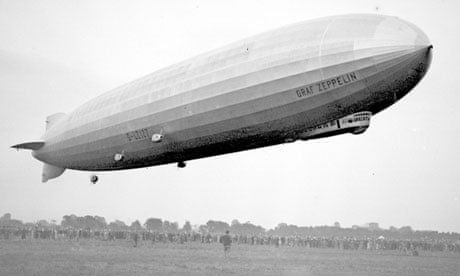Although Winston Churchill dismissed them as "enormous bladders of combustible and explosive gas" before the first world war began, the leviathans that loomed out of the night skies to drop their bombs on England nearly a century ago exploded the illusion of civilian safety on the home front for ever.
To millions of sausage-starved Germans, however, Zeppelins were perhaps less harbingers of a new kind of warfare than colossal reminders of the culinary sacrifices required by the fatherland.
According to a new documentary, the quantity of cow intestines used in manufacturing the airships was so enormous – and the military appetite for the dirigibles so strong – that the making of sausages was temporarily outlawed in Germany and allied or occupied parts of Austria, Poland and northern France.
With the guts from more than 250,000 cows needed to produce the bags that held the hydrogen gas in each Zeppelin, the German war machine had to choose between long-range bombing and wurst. It chose the former.
A document prepared in 1922 for the US National Advisory Committee for Aeronautics shows just how important cow guts – also known as goldbeater's skins – were to the military effort.
"The collection of the goldbeater's skins was very systematic in Germany during the war," it reads. "Each butcher was required to deliver the ones from the animals he killed. Agents exercised strict control in Austria, Poland and northern France, where it was forbidden to make sausages."
Dr Hugh Hunt, a senior lecturer in engineering at Cambridge University who looked into the airships for the Channel 4 programme, Attack of the Zeppelins, said he was as surprised as anyone by the intestinal and legal revelations.
"Everybody's been interested in the sausages," he said. "But without supplies from their allies, Germany wouldn't have had enough sausage skins."
To understand exactly how the guts were used, Hunt and his colleagues visited a Middlesbrough factory to see how sausage skins are made. It was there that they realised that by wetting the skins, stretching them and allowing them to dry again, they could be bonded to make perfect hydrogen holders.
His professional curiosity, however, was more drawn to the physical strengths and weaknesses of the giant airships than to questions of bovine supply and demand.
"The most interesting thing is that you would have thought that a big bag of hydrogen would be easy to shoot down and set light to," he said. "But for the best part of a year and a half, it was impossible to shoot Zeppelins down. They built 140 of these enormous airships over that period and it was only at the very end of that – towards the end of the war in 1917 – that we finally worked out how to shoot them down."
Hunt also discovered that some of the credit for finding the best way to down the dirigibles is owed to his great uncle, Jim Buckingham, the designer of the incendiary bullet. The British eventually realised that the resilient airships could be destroyed by firing explosive bullets to breach the skin and allow the hydrogen to mix with oxygen, and then following up with incendiary bullets to create an explosion.
"I remember my father talking about an Uncle Jim who had worked on tracer bullets later, in world war two, but for some reason I had never made the connection," he said.
"It wasn't until I was chatting to my cousin about it that it clicked, and I realised that we were talking about the same person."
After hours spent researching the Zeppelins – which were dispatched on bombing raids that killed 1,500 people between 1915 and 1917 – Hunt feels hydrogen-filled airships would eventually have proved popular, safe and effective had interest in them not ended with the Hindenburg disaster of 1937. He also takes issue with Churchill's uncharitable appraisal of the Zeppelin.
"I think that's fine in principle but in practice, they're not explosive at all," he said. "I think it was a bit of a soundbite."
Attack of the Zeppelins is on Channel 4 at 8pm on 26 August

Comments (…)
Sign in or create your Guardian account to join the discussion